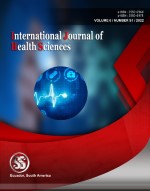In-vitro evaluation of antimicrobial efficacy of triple antibiotic paste, metapex and newly introduced iodine based asphaline temp as intracanal medicament against enterococcus faecalis
Keywords:
asphaline temp, calcium hydroxide, colony-forming units, intra-canal medicament, triple antibiotic pasteAbstract
Background: Microorganisms and their products are considered as the etiological agents of pulp necrosis and peri-radicular lesions. They may survive during endodontic procedures due to anatomical structural complexities and limitations of access by instrumentation and irrigants. The present study was conducted to assess antimicrobial efficacy of newly introduced iodine based Asphaline Temp, Triple antibiotic paste and Calcium hydroxide based Metapex against Enterococcus faecalis. Materials & Methods: 90 extracted, single-rooted human permanent teeth were instrumented and autoclaved. Samples were inoculated with the pure culture of E. faecalis and incubated. After incubation, colony-forming units (CFUs) were recorded before medication. Each group was further divided into 3 subgroups based on time duration of testing for days – 1 day, 5 days, and 7 days, containing 10 samples each. Group I – Asphaline Temp; Group II – Triple antibiotic paste (TAP); Group III – Metapex. The various time interval bacterial CFUs within the group were compared. Results: Percentage reduction in bacteria count on 1 day, 5 day and 7 day in Group I (Asphaline Temp) was 77.2, 96.5 and 98.3; in Group II (TAP) was 70.5, 90.4 and 93.2 and in Group III (Metapex ) was 25.8, 46.2 and 58.2.
Downloads
References
Adl, A., Shojaee, N. S., & Motamedifar, M. (2012). A comparison between the antimicrobial effects of triple antibiotic paste and calcium hydroxide against Entrococcus faecalis. Iranian endodontic journal, 7(3), 149.
Alam, T., Nakazawa, F., Nakajo, K., Uematsu, H., & Hoshino, E. (2005). Susceptibility of Enterococcus faecalis to a combination of antibacterial drugs (3Mix) in vitro. Journal of oral biosciences, 47(4), 315-320.
Bandekar, S., Amin, A., Kshirsagar, S., Vathsala, N., Chinmay, V., & Sayyad, A. (2021). Comparative evaluation of antimicrobial efficacy of Asphaline Temp, Triple antibiotic Paste and Ultracal XS against Enterococcus faecalis–An in vitro study. Endodontology, 33(1), 6.
Cherry, M., Daly, C. G., Mitchell, D., & Highfield, J. (2007). Effect of rinsing with povidone–iodine on bacteraemia due to scaling: a randomized?controlled trial. Journal of clinical periodontology, 34(2), 148-155.
Chittrarasu, M., Sathyanarayana, S. S., Ahamed, S., Aberna, A., Bhavani, S., & Rajaraman, G. (2019). Antimicrobial efficacy of liquorice against Enterococcus faecalis biofilms in various concentrations at time-dependent variables: An in vitro study. Journal of Conservative Dentistry: JCD, 22(1), 7.
Hoshino, E., Kurihara?Ando, N., Sato, I., Uematsu, H., Sato, M., Kota, K., & Iwaku, M. (1996). In?vitro antibacterial susceptibility of bacteria taken from infected root dentine to a mixture of ciprofloxacin, metronidazole and minocycline. International endodontic journal, 29(2), 125-130.
Kim, J. H., Kim, Y., Shin, S. J., Park, J. W., & Jung, I. Y. (2010). Tooth discoloration of immature permanent incisor associated with triple antibiotic therapy: a case report. Journal of endodontics, 36(6), 1086-1091.
Lima, R. K. P., Guerreiro?Tanomaru, J. M., Faria?Júnior, N. B., & Tanomaru?Filho, M. (2012). Effectiveness of calcium hydroxide?based intracanal medicaments against Enterococcus faecalis. International endodontic journal, 45(4), 311-316.
Madhubala, M. M., Srinivasan, N., & Ahamed, S. (2011). Comparative evaluation of propolis and triantibiotic mixture as an intracanal medicament against Enterococcus faecalis. Journal of endodontics, 37(9), 1287-1289.
Sato, I., Ando?Kurihara, N., Kota, K., Iwaku, M., & Hoshino, E. (1996). Sterilization of infected root?canal dentine by topical application of a mixture of ciprofloxacin, metronidazole and minocycline in situ. International endodontic journal, 29(2), 118-124.
Schreier, H., Erdos, G., Reimer, K., König, B., König, W., & Fleischer, W. (1997). Molecular effects of povidone-iodine on relevant microorganisms: an electron-microscopic and biochemical study. Dermatology, 195(Suppl. 2), 111-116.
Shaik, J., Garlapati, R., Nagesh, B., Sujana, V., Jayaprakash, T., & Naidu, S. (2014). Comparative evaluation of antimicrobial efficacy of triple antibiotic paste and calcium hydroxide using chitosan as carrier against Candida albicans and Enterococcus faecalis: An in vitro study. Journal of conservative dentistry: JCD, 17(4), 335.
Published
How to Cite
Issue
Section
Copyright (c) 2022 International journal of health sciences

This work is licensed under a Creative Commons Attribution-NonCommercial-NoDerivatives 4.0 International License.
Articles published in the International Journal of Health Sciences (IJHS) are available under Creative Commons Attribution Non-Commercial No Derivatives Licence (CC BY-NC-ND 4.0). Authors retain copyright in their work and grant IJHS right of first publication under CC BY-NC-ND 4.0. Users have the right to read, download, copy, distribute, print, search, or link to the full texts of articles in this journal, and to use them for any other lawful purpose.
Articles published in IJHS can be copied, communicated and shared in their published form for non-commercial purposes provided full attribution is given to the author and the journal. Authors are able to enter into separate, additional contractual arrangements for the non-exclusive distribution of the journal's published version of the work (e.g., post it to an institutional repository or publish it in a book), with an acknowledgment of its initial publication in this journal.
This copyright notice applies to articles published in IJHS volumes 4 onwards. Please read about the copyright notices for previous volumes under Journal History.
















